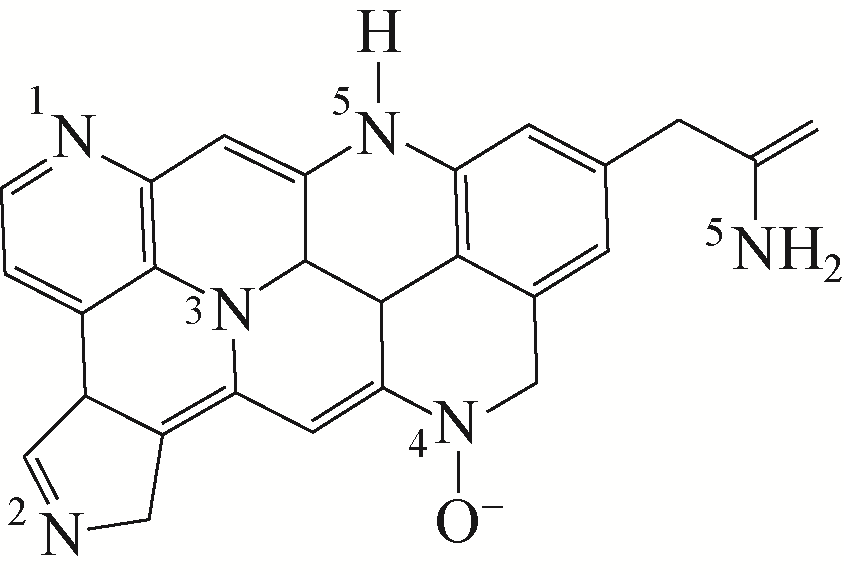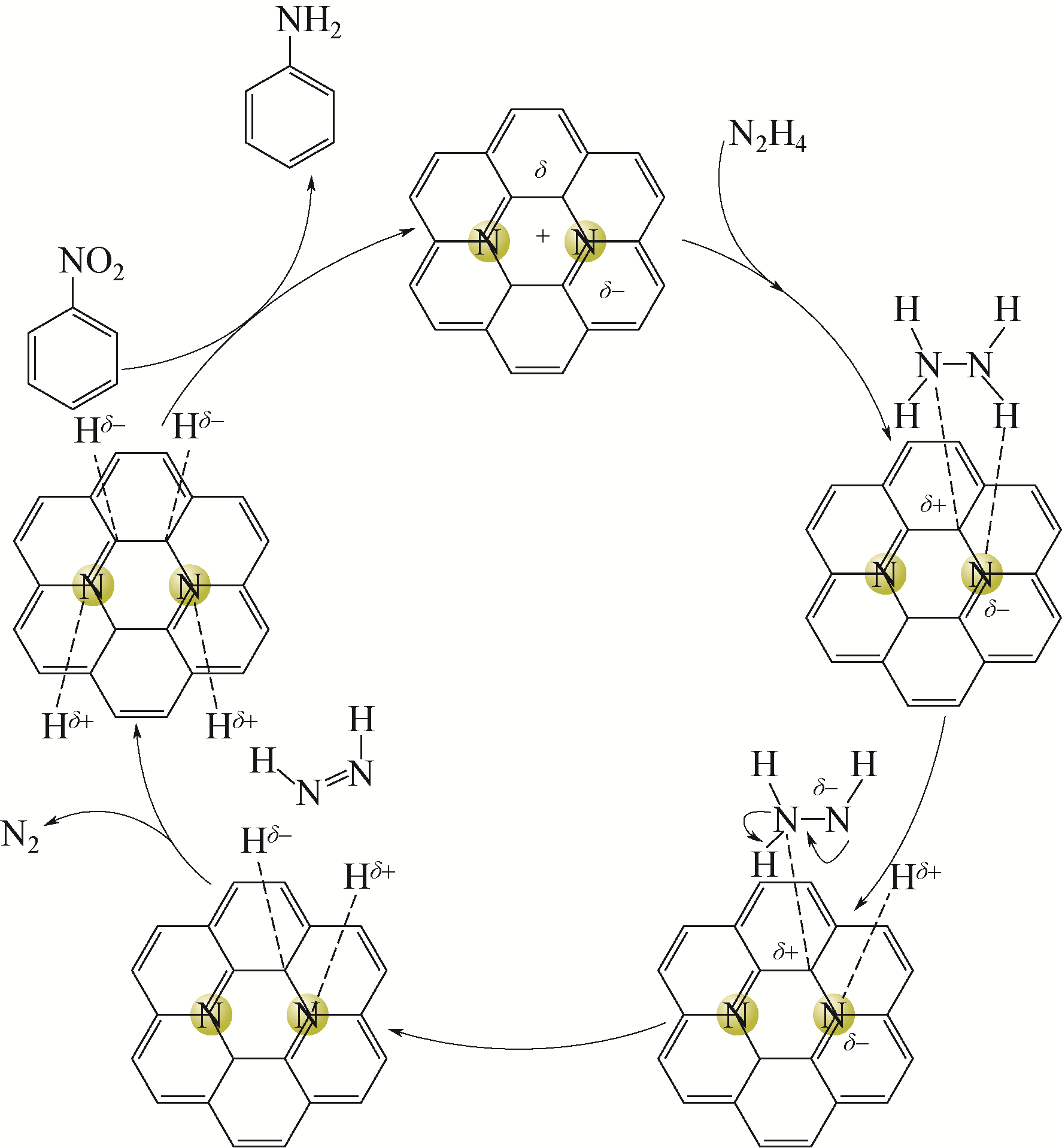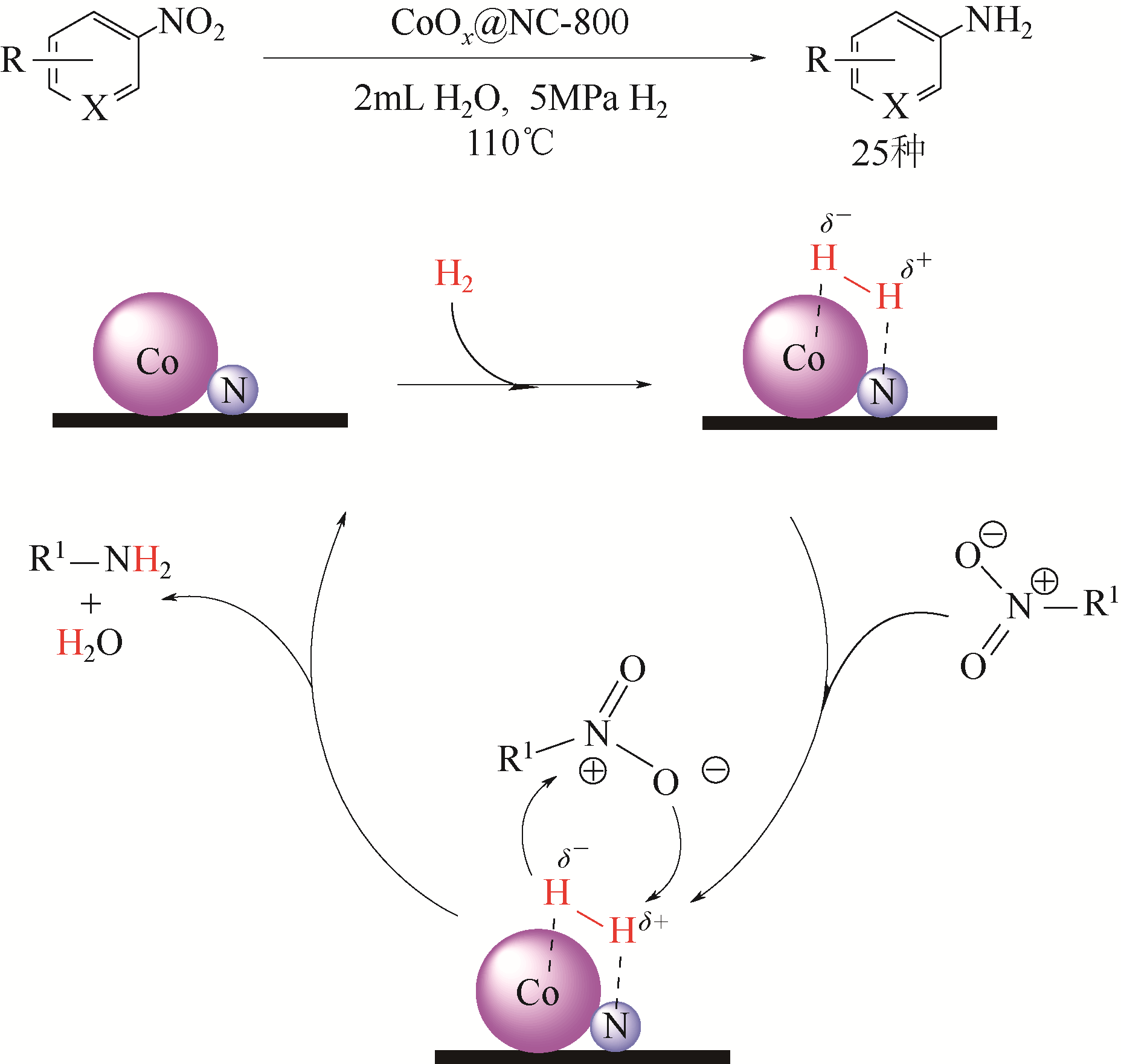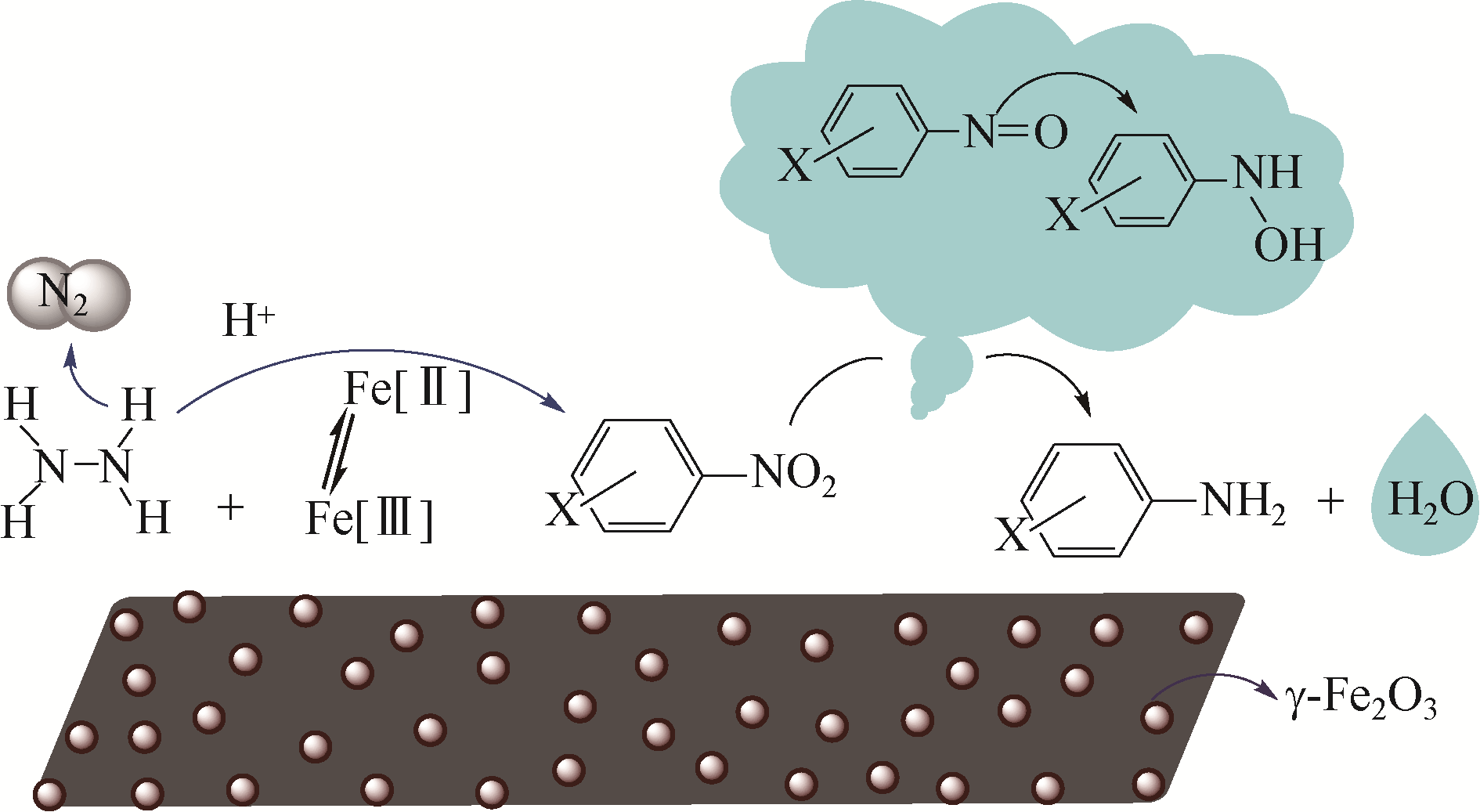Chemical Industry and Engineering Progress ›› 2021, Vol. 40 ›› Issue (2): 778-788.DOI: 10.16085/j.issn.1000-6613.2020-0609
• Industrial catalysis • Previous Articles Next Articles
Recent development on doped porous carbon materials for catalytic reduction of nitrobenzene
Beili LU( ), Xing LIU, Zhu YIN, Biao HUANG
), Xing LIU, Zhu YIN, Biao HUANG
- College of Material Engineering, Fujian Agriculture and Forestry University, Fuzhou 350108, Fujian, China
-
Received:2002-04-17Revised:2020-06-04Online:2021-02-09Published:2021-02-05 -
Contact:Beili LU
掺杂多孔碳材料催化硝基苯还原反应的研究进展
- 福建农林大学材料工程学院,福建 福州 350108
-
通讯作者:卢贝丽 -
作者简介:卢贝丽(1984—),女,博士,副教授,主要从事生物质资源高值化利用与新材料的研究。E-mail:lubl@fafu.edu.cn 。 -
基金资助:国家自然科学基金(31770611);福建省自然科学基金(2019J01388);福建农林大学科技创新专项基金(CXZX2018005)
CLC Number:
Cite this article
Beili LU, Xing LIU, Zhu YIN, Biao HUANG. Recent development on doped porous carbon materials for catalytic reduction of nitrobenzene[J]. Chemical Industry and Engineering Progress, 2021, 40(2): 778-788.
卢贝丽, 刘杏, 尹铸, 黄彪. 掺杂多孔碳材料催化硝基苯还原反应的研究进展[J]. 化工进展, 2021, 40(2): 778-788.
share this article
Add to citation manager EndNote|Ris|BibTeX
URL: https://hgjz.cip.com.cn/EN/10.16085/j.issn.1000-6613.2020-0609
| 催化剂 | 第一步HNO3 | 第二步KOH | 第三步H2O2 | 转化率/% | 选择性/% |
|---|---|---|---|---|---|
| non-C | no | no | no | 42.1 | 100 |
| PC | no | 活化(1h) | no | 62.7 | 100 |
| OPC | no | 活化(1h) | 24 | 83.2 | 100 |
| ONPC | 氧化(16h) | 活化(1h)① | no | 100 | 100 |
| 催化剂 | 第一步HNO3 | 第二步KOH | 第三步H2O2 | 转化率/% | 选择性/% |
|---|---|---|---|---|---|
| non-C | no | no | no | 42.1 | 100 |
| PC | no | 活化(1h) | no | 62.7 | 100 |
| OPC | no | 活化(1h) | 24 | 83.2 | 100 |
| ONPC | 氧化(16h) | 活化(1h)① | no | 100 | 100 |
| 催化剂 | 4-硝基苯酚的转化率 /% | (N/B) /% | 表观活化能 /kJ·mol-1 |
|---|---|---|---|
| NPC | 16 | 11.3/0 | 48.2 |
| B-NPC-800 | 32 | 8.5/0 | 39.1 |
| B-NPC-1000 | 77 | 4.2/0.9 | 30.2 |
| B-NPC-1200 | 94 | 1.9/1.5 | 27.0 |
| 催化剂 | 4-硝基苯酚的转化率 /% | (N/B) /% | 表观活化能 /kJ·mol-1 |
|---|---|---|---|
| NPC | 16 | 11.3/0 | 48.2 |
| B-NPC-800 | 32 | 8.5/0 | 39.1 |
| B-NPC-1000 | 77 | 4.2/0.9 | 30.2 |
| B-NPC-1200 | 94 | 1.9/1.5 | 27.0 |
| 底物 | 反应时间/h | 转化率/% | 选择性/% |
|---|---|---|---|
 | 0.5 | 100 | 99.5 |
 | 0.5 | 100 | 98.8 |
 | 0.5 | 100 | 95.5 |
 | 2 | 100 | 100 |
 | 2 | 100 | 99.2 |
 | 2 | 100 | 100 |
 | 2 | 100 | 100 |
 | 2 | 100 | 85.4 |
 | 2 | 100 | 70 |
| 底物 | 反应时间/h | 转化率/% | 选择性/% |
|---|---|---|---|
 | 0.5 | 100 | 99.5 |
 | 0.5 | 100 | 98.8 |
 | 0.5 | 100 | 95.5 |
 | 2 | 100 | 100 |
 | 2 | 100 | 99.2 |
 | 2 | 100 | 100 |
 | 2 | 100 | 100 |
 | 2 | 100 | 85.4 |
 | 2 | 100 | 70 |
| 1 | CORMA A, SERNA P. Chemoselective hydrogenation of nitro compounds with supported gold catalysts[J]. Science, 2006, 313(5785): 332-334. |
| 2 | MANTHA R, TAYLOR K E, BISWAS N, et al. A continuous system for Fe0 reduction of nitrobenzene in synthetic wastewater[J]. Environmental Science and Technology, 2001, 35(15): 3231-3236. |
| 3 | 王同洲, 王鸿. 多孔碳材料的研究进展[J]. 中国科学(化学), 2019, 49(5): 729-740. |
| WANG T Z, WANG H. Research progress on porous carbon materials[J]. Scientia Sinica Chimica, 2019, 49(5): 729-740. | |
| 4 | ZHANG L H, SHI Y M, WANG Y, et al. Nanocarbon catalysts: recent understanding regarding the active sites[J]. Advanced Science, 2020, 7(5): 1902126. |
| 5 | SONG J, HUANG Z F, PAN L, et al. Review on selective hydrogenation of nitroarene by catalytic, photocatalytic and electrocatalytic reactions[J]. Applied Catalysis B: Environmental, 2018, 227: 386-408. |
| 6 | NASEEM K, BEGUM R, FAROOQI Z H. Catalytic reduction of 2-nitroaniline: a review[J]. Environmental Science & Pollution Research, 2017, 24(7): 1-15. |
| 7 | YANG Y, GU L, GUO S W, et al. N-doped mesoporous carbons: from synthesis to applications as metal-free reduction catalysts and energy storage materials[J]. Frontiers in Chemistry, 2019, 7: 761. |
| 8 | JEON I Y, NOH H J, BAEK J B. Nitrogen-doped carbon nanomaterials: synthesis, characteristics and applications[J]. Chemistry: an Asian Journal, 2020, 15: 2282-2293. |
| 9 | LIAO C J, LIU B, CHI Q, et al. Nitrogen-doped carbon materials for the metal-free reduction of nitro compounds[J]. ACS Applied Materials & Interfaces, 2018, 10(51): 44421-44429. |
| 10 | 王嘉, 李福伟. 氮掺杂碳包覆金属催化剂的制备及其在多相催化反应中的应用[J]. 中国科学(化学), 2018, 48(12): 1587-1602. |
| WANG J, LI F W. Synthesis of a N-doped carbon coating metal catalyst and its application in the heterogeneously catalytic reaction[J]. Scientia Sinica Chimica, 2018, 48(12): 1587-1602. | |
| 11 | 李晓微, 许海芬, 周晋, 等. 氮掺杂碳材料负载Pd纳米催化剂在有机反应中的最新研究进展[J]. 有机化学, 2018, 38(8): 74-86. |
| LI X W, XU H F, ZHOU J, et al. Recent progress of N-doped carbon materials supported Pd nanocatalysts in organic reactions[J]. Chinese Journal of Organic Chemistry, 2018, 38(8): 74-86. | |
| 12 | HE L, WENIGER F, NEUMANN H, et al. Synthesis, characterization, and application of metal nanoparticles supported on nitrogen-doped carbon: catalysis beyond electrochemistry[J]. Angewandte Chemie International Edition, 2016, 55(41): 12582-12594. |
| 13 | SHAN J X, SUN X Q, ZHENG S Y, et al. Graphitic N-dominated nitrogen-doped carbon nanotubes as efficient metal-free catalysts for hydrogenation of nitroarenes[J]. Carbon, 2019, 146: 60-69. |
| 14 | 余正发, 王旭珍, 刘宁, 等. N掺杂多孔碳材料研究进展[J]. 化工进展, 2013, 32(4): 824-831. |
| YU Z F, WANG X Z, LIU N, et al. Recent progress of N-doped porous carbon materials[J]. Chemical Industry and Engineering Progress, 2013, 32(4): 824-831. | |
| 15 | ZHANG W, WU W, LONG Y, et al. Co-Ag alloy protected by nitrogen doped carbon as highly efficient and chemoselective catalysts for the hydrogenation of halogenated nitrobenzenes[J]. Journal of Colloid and Interface Science, 2018, 522: 217-227. |
| 16 | LIU C, TANG P, CHEN A. et al. One-step assembly of N-doped partially graphitic mesoporous carbon for nitrobenzene reduction[J]. Materials Letters, 2013, 108: 285-288. |
| 17 | YANG Y, ZHANG W, MA X H, et al. Facile construction of mesoporous N-doped carbons as highly efficient 4-nitrophenol reduction catalysts[J]. ChemCatChem, 2015, 7(21): 3454-3459. |
| 18 | LIU N, DING L, LI H, et al. N-doped nanoporous carbon as efficient catalyst for nitrobenzene reduction in sulfide-containing aqueous solutions[J]. Journal of Colloid & Interface Science, 2017, 490: 677-684. |
| 19 | FUJITA S I, WATANABE H, KATAGIRI A, et al. Nitrogen and oxygen-doped metal-free carbon catalysts for chemoselective transfer hydrogenation of nitrobenzene, styrene, and 3-nitrostyrene with hydrazine[J]. Journal of Molecular Catalysis A: Chemical, 2014, 393: 257-262. |
| 20 | WEI Q H, QIN F F, MA Q X, et al. Coal tar-and residual oil-derived porous carbon as metal-free catalyst for nitroarene reduction to aminoarene[J]. Carbon, 2019, 141: 542-552. |
| 21 | LI L Y, LI L, CUI C Y, et al. Hierarchical hollow covalent organic frameworks-derived heteroatom-doped carbon spheres for metal-free catalysis[J]. ChemSusChem, 2017, 10(24): 4921-4926. |
| 22 | NGUYEN C V, LEE S, CHUNG Y G, et al. Synergistic effect of metal-organic framework-derived boron and nitrogen heteroatom-doped three-dimensional porous carbons for precious-metal-free catalytic reduction of nitroarenes[J]. Applied Catalysis B: Environmental, 2019, 257: 117888. |
| 23 | LIU S, CUI L, PENG Z, et al. Eco-friendly synthesis of N, S co-doped hierarchical nanocarbon as a highly efficient metal-free catalyst for the reduction of nitroarenes[J]. Nanoscale, 2018, 10(46): 21764-21771. |
| 24 | BEGUM R, REHAN R, FAEQQAI Z H, et al. Physical chemistry of catalytic reduction of nitroarenes using various nanocatalytic systems: past, present, and future[J]. Journal of Nanoparticle Research, 2016, 18(8): 231. |
| 25 | CHEN L, ZHANG L, CHEN Z, et al. A covalent organic framework-based route to the in situ encapsulation of metal nanoparticles in N-rich hollow carbon spheres[J]. Chemical Science, 2016, 7(9): 6015-6020. |
| 26 | ZUO P P, DUAN J Q, FAN H L, et al. Facile synthesis high nitrogen-doped porous carbon nanosheet from pomelo peel and as catalyst support for nitrobenzene hydrogenation[J]. Applied Surface Science, 2018, 435: 1020-1028. |
| 27 | LU C S, WANG M J, FENG Z L, et al. A phosphorus-carbon framework over activated carbon supported palladium nanoparticles for the chemoselective hydrogenation of para-chloronitrobenzene[J]. Catalysis Science & Technology, 2017, 7(7): 1581-1589. |
| 28 | ZHANG Q F, LI K, XIANG Y Z, et al. Sulfur-doped porous carbon supported palladium catalyst for high selective O-chloro-nitrobenzene hydrogenation[J]. Applied Catalysis A: General, 2019, 581: 74-81. |
| 29 | LIANG J, ZHANG X, JING L, et al. N-doped ordered mesoporous carbon as a multifunctional support of ultrafine Pt nanoparticles for hydrogenation of nitroarenes[J]. Chinese Journal of Catalysis, 2017, 38(7): 1252-1260. |
| 30 | SHOKOUHIMEHR M, KIM T, JUN S W, et al. Magnetically separable carbon nanocomposite catalysts for efficient nitroarene reduction and Suzuki reactions[J]. Applied Catalysis A: General, 2014, 476: 133-139. |
| 31 | ZHONG H, GONG Y Q, LIU W H, et al. Robust ultrafine ruthenium nanoparticles enabled by covalent organic gel precursor for selective reduction of nitrobenzene in water[J]. Dalton Transactions, 2019, 48(7): 2345-2351. |
| 32 | BIDE Y, NABID M R, DASTAR F. Poly(2-aminothiazole) as a unique precursor for nitrogen and sulfur co-doped porous carbon: immobilization of very small gold nanoparticles and its catalytic application[J]. RSC Advances, 2015, 5(78): 63421-63428. |
| 33 | WESTERHAUS F A, JAGADEESH R V, WIENHÇFER G, et al. Heterogenized cobalt oxide catalysts for nitroarene reduction by pyrolysis of molecularly defined complexes[J]. Nature Chemistry, 2013, 5: 537-543. |
| 34 | HU A, LU X, CAI D, et al. Selective hydrogenation of nitroarenes over MOF-derived Co@CN catalysts at mild conditions[J]. Molecular Catalysis, 2019, 472: 27-36. |
| 35 | SUN X H, OLIVOS-SUAREZ A I, OSADCHII D, et al. Single cobalt sites in mesoporous N-doped carbon matrix for selective catalytic hydrogenation of nitroarenes[J]. Journal of Catalysis, 2018, 357: 20-28. |
| 36 | SONG T, REN P, DUAN Y N, et al. Cobalt nanocomposites on N-doped hierarchical porous carbon for highly selective formation of anilines and imines from nitroarenes[J]. Green Chemistry, 2018, 20(20): 4629-4637. |
| 37 | CUI X L, ZHANG Q L, TIAN M, et al. Facile fabrication of γ-Fe2O3-nanoparticle modified N-doped porous carbon materials for the efficient hydrogenation of nitroaromatic compounds[J]. New Journal of Chemistry, 2017, 41(18): 10165-10173. |
| 38 | TIAN M, CUI X L, YUAN M, et al. Efficient chemoselective hydrogenation of halogenated nitrobenzenes over an easily prepared γ-Fe2O3-modified mesoporous carbon catalyst[J]. Green Chemistry, 2017, 19(6): 1548-1554. |
| 39 | WANG H, LIU X, XU G, et al. In situ synthesis of Fe-N-C catalysts from cellulose for hydrogenation of nitrobenzene to aniline[J]. Chinese Journal of Catalysis, 2019, 40: 1557-1565. |
| 40 | YANG F, WANG M J, LIU W, et al. Atomically dispersed Ni as the active site towards selective hydrogenation of nitroarenes[J]. Green Chemistry, 2019, 21(3): 704-711. |
| [1] | ZHENG Qian, GUAN Xiushuai, JIN Shanbiao, ZHANG Changming, ZHANG Xiaochao. Photothermal catalysis synthesis of DMC from CO2 and methanol over Ce0.25Zr0.75O2 solid solution [J]. Chemical Industry and Engineering Progress, 2023, 42(S1): 319-327. |
| [2] | ZHAO Wei, ZHAO Deyin, LI Shihan, LIU Hongda, SUN Jin, GUO Yanqiu. Synthesis and application of triazine drag reducing agent for nature gas pipeline [J]. Chemical Industry and Engineering Progress, 2023, 42(S1): 391-399. |
| [3] | WANG Zhengkun, LI Sifang. Green synthesis of gemini surfactant decyne diol [J]. Chemical Industry and Engineering Progress, 2023, 42(S1): 400-410. |
| [4] | ZHANG Jie, WANG Fangfang, XIA Zhonglin, ZHAO Guangjin, MA Shuangchen. Current SF6 emission, emission reduction and future prospects under “carbon peaking and carbon neutrality” [J]. Chemical Industry and Engineering Progress, 2023, 42(S1): 447-460. |
| [5] | WANG Lele, YANG Wanrong, YAO Yan, LIU Tao, HE Chuan, LIU Xiao, SU Sheng, KONG Fanhai, ZHU Canghai, XIANG Jun. Influence of spent SCR catalyst blending on the characteristics and deNO x performance for new SCR catalyst [J]. Chemical Industry and Engineering Progress, 2023, 42(S1): 489-497. |
| [6] | ZHAO Jingchao, TAN Ming. Effect of surfactants on the reduction of industrial saline wastewater by electrodialysis [J]. Chemical Industry and Engineering Progress, 2023, 42(S1): 529-535. |
| [7] | DENG Liping, SHI Haoyu, LIU Xiaolong, CHEN Yaoji, YAN Jingying. Non-noble metal modified vanadium titanium-based catalyst for NH3-SCR denitrification simultaneous control VOCs [J]. Chemical Industry and Engineering Progress, 2023, 42(S1): 542-548. |
| [8] | SHU Bin, CHEN Jianhong, XIONG Jian, WU Qirong, YU Jiangtao, YANG Ping. Necessity analysis of promoting the development of green methanol under the goal of carbon neutrality [J]. Chemical Industry and Engineering Progress, 2023, 42(9): 4471-4478. |
| [9] | GENG Yuanze, ZHOU Junhu, ZHANG Tianyou, ZHU Xiaoyu, YANG Weijuan. Homogeneous/heterogeneous coupled combustion of heptane in a partially packed bed burner [J]. Chemical Industry and Engineering Progress, 2023, 42(9): 4514-4521. |
| [10] | GAO Yanjing. Analysis of international research trend of single-atom catalysis technology [J]. Chemical Industry and Engineering Progress, 2023, 42(9): 4667-4676. |
| [11] | ZHANG Qi, ZHAO Hong, RONG Junfeng. Research progress of anti-toxicity electrocatalysts for oxygen reduction reaction in PEMFC [J]. Chemical Industry and Engineering Progress, 2023, 42(9): 4677-4691. |
| [12] | GE Quanqian, XU Mai, LIANG Xian, WANG Fengwu. Research progress on the application of MOFs in photoelectrocatalysis [J]. Chemical Industry and Engineering Progress, 2023, 42(9): 4692-4705. |
| [13] | LI Dongze, ZHANG Xiang, TIAN Jian, HU Pan, YAO Jie, ZHU Lin, BU Changsheng, WANG Xinye. Research progress of NO x reduction by carbonaceous substances for denitration in cement kiln [J]. Chemical Industry and Engineering Progress, 2023, 42(9): 4882-4893. |
| [14] | WANG Chen, BAI Haoliang, KANG Xue. Performance study of high power UV-LED heat dissipation and nano-TiO2 photocatalytic acid red 26 coupling system [J]. Chemical Industry and Engineering Progress, 2023, 42(9): 4905-4916. |
| [15] | ZHU Chuanqiang, RU Jinbo, SUN Tingting, XIE Xingwang, LI Changming, GAO Shiqiu. Characteristics of selective non-catalytic reduction of NO x with solid polymer denitration agent [J]. Chemical Industry and Engineering Progress, 2023, 42(9): 4939-4946. |
| Viewed | ||||||
|
Full text |
|
|||||
|
Abstract |
|
|||||






